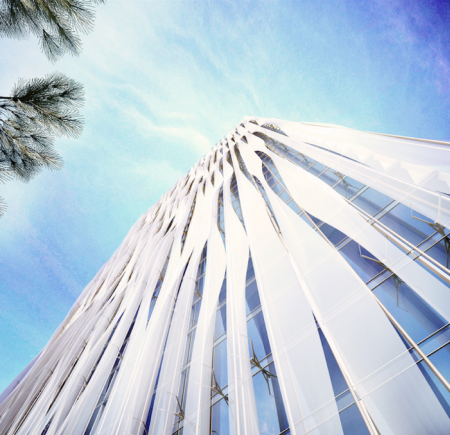Using Shade to Create Comfortable, Energy Efficient Buildings
Humanity has a love-hate relationship with the sun. Its warm rays sustain us on biological and emotional levels, but too much sun poses health risks.
While people have an affinity for the outdoors, in the course of our lives we spend on average 90 percent of our time indoors1. That makes thoughtful shade design in our homes, offices, hospitals, schools and restaurants imperative for two reasons:
- Shade creates comfortable spaces where people can thrive.
- Shade boosts energy efficiency and contributes to a smaller carbon footprint.
Shade Creates Visual and Climatic Comfort
Shade design is a key ingredient in comfortable spaces. On the inside of the building, it helps control indoor temperatures and reduces glare. Blocking or filtering sunlight reduces heat gain, while also cutting direct glare from windows or reflected glare on computer screens and other surfaces.
While interior shading devices like roller blinds are often the default choice for controlling sunlight, exterior shading opens up new possibilities to create spaces that promote health and wellness. Awnings, shade sails, canopies or even newly envisioned shade structures installed on the building’s exterior work harder by
- Blocking harsh, direct sunlight;
- Admitting soft, ambient light;
- Maintaining a view to the outside.
With more and more research showing a positive connection between human health, nature views and natural light, it’s incumbent upon architects and designers to tap into shade design’s potential for improving the way people live, work and play.
Doel Fresse, an architect and industrial designer based in Puerto Rico, envisioned a building shade system called Helicon, which has a geometric design inspired by heliconia flowers common to the Caribbean. Helicon is a dynamic façade retrofit system for glass-clad buildings and is designed to expand or contract depending on the amount of desired light and view.

Shade Improves Building Energy Efficiency
Another advantage of exterior shading is that it blocks sunlight before it comes inside, resulting in a significant reduction in heat gain. Another architect, San Francisco-based Arman Hadilou designed a shade concept specifically for this purpose.
Hadilou’s Responsive Shading System uses a series of fabric panels mounted on a metal frame attached to the building’s exterior. The system can be integrated into the building’s automated lighting, twisting the panels to bring in more natural light or flattening to block it, depending on the time of day and sun angle.
Such automated systems can help reduce a building’s energy loads to achieve a smaller carbon footprint. Certification programs have begun to recognize shade’s dual role: LEED and WELL Building Standard, recognize the potential of shade to boost both building energy efficiency and occupant wellbeing. The European Union’s Energy Performance Buildings Directive has recognized solar shading as a key element in improving building energy efficiency.
Shade Can Be Artful and Functional
In the face of a warming planet, the need for building shade is unquestioned, but what kind of shade should it be? Both designs above take shade design a step further with the addition of eye-catching designs. Helicon utilizes repeating geometry, while Responsive Shading System brings beautiful fluidity to buildings with typically hard lines.
Using fabric allows for more creative shade designs because it is pliable, comes in a wide variety of colors and is light weight. The future of shade design for buildings lies in the intersection of health and wellness, energy efficiency and creativity.
View more new thinking in shade design at futureofshade.com.
1 U.S. EPA Report on the Environment, https://cfpub.epa.gov/roe/chapter/air/indoorair.cfm
